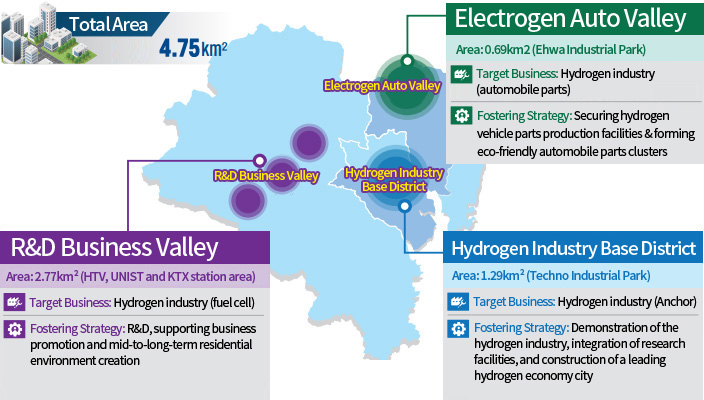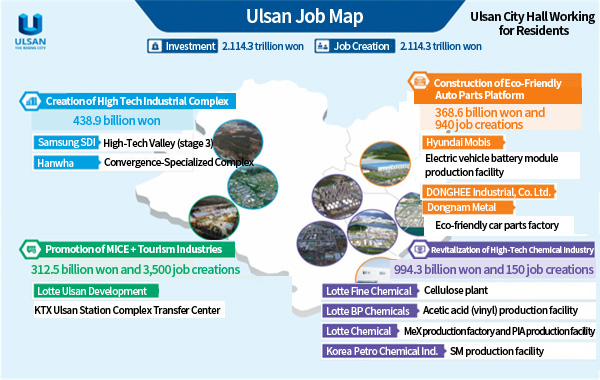Connection Plan
Space Division and Connection among Districts
Space Division

- Total Area
- 4.70km2
- Hydrogen Industry Base District
- Area: 1.29km² (Techno Industrial Park)
- Target Business: Hydrogen industry (Anchor)
- Fostering Strategy: Demonstration of the hydrogen industry, integration of research facilities, and construction of a leading hydrogen economy city
- Electrogen Auto Valley
- Area: 0.69km2 (Ehwa Industrial Park)
- Target Business: Hydrogen industry (automobile parts)
- Fostering Strategy: Securing hydrogen vehicle parts production facilities & forming eco-friendly automobile parts clusters
- R&D Business Valley
- Area: 2.72km² (HTV, UNIST and KTX station area)
- Target Business: Hydrogen industry (fuel cell)
- Fostering Strategy: R&D, supporting business promotion and mid-to-long-term residential environment creation
District Selection Criteria
- Differentiation between Major Attracting Industries
- UFEZ selects the hydrogen industry as a key attraction industry and selects a region that can easily fulfill its role as a key industry.
- Utilization of Previously Developed Area
- In order to solve the untapped problem, which is the limitation of the existing free economic zone, ufezEng improves its development efficiency by selecting the development plan establishment area, the area under development, and the development completion area.
- Compatibility with National and Regional Plan
- ufezEng will expand the supply of renewable energies and cooperate with regional and national projects by maximizing economic feasibility and technology convergence and investment attraction.
- Comprehensive Connection among Districts
- ufezEng plans to divide districts to allow each district to support each other by providing special functions to each district.
District Connection Plan
- Considering balanced development and connectivity based on east and west axes.
- Connectiing and utilizing Special Economic Zones and the infrastructure industry.
- The following are the hydrogen industries linked to large companies in the petrochemical industry, the automobile industry, and the shipbuilding industry, which are the major infrastructure industries of Ulsan:
1. Production of hydrogen storage devices, hydrogen-fueled car parts, etc.
2. Production of hydrogen-fueled cars and hydrogen ships.
- The following are the hydrogen industries linked to large companies in the petrochemical industry, the automobile industry, and the shipbuilding industry, which are the major infrastructure industries of Ulsan:
- Establishment and Connection of Base District and Business District for Each Major Business Type
- ufezEng establishes key business sectors for each production district and set up business support districts, thereby fulfilling its vision and goals through inter-district interconnection.
Plan for Connecting National and Regional Policies
Status of Special Economic Zones in Ulsan
- The designated special economic zones in Ulsan include a free trade zone, industrial complexes, a foreign investment zone, and an innovation cluster. In addition, City Hall has applied for the designation of the small strong R&D special zone and completed to designate the regulation-free special zone.
| Classification | Area | Major Industry | Note |
|---|---|---|---|
| Free Trade Zone | A total area of 819,000 ㎡ with 35 companies | Machine, metal and plant equipment | Designation and construction completed |
| Industrial Complex | A total of 31 complexes with an area of 88.831 million ㎡ National Industrial Complex: 2 , General Industrial Complex: 24 High-Tech Industrial Complex: 1, Agricultural Industrial Complex: 4 |
Petrochemistry and automobile parts, etc. | Designation and construction completed (some are under construction.) |
| Foreign Investment Zone | A total area of 439,800㎡ with 10 companies | Petrochemistry, chemical products, gas, etc. | Designation and construction completed |
| Innovation Cluster | A total area of 10,117㎢ with 1 core district, 2 cooperation districts | Future automobile industry | Designation and construction completed (some are under construction.) |
| Small Strong R&D Special Zone | A total area of 1.84㎢ | Eco-friendly energy, bio health care and smart machine parts | Designation application completed |
| Regulation-Free Special Zone | - | Hydrogen green mobility | Designation completed |
- Arrangement and Connection Plan
- Support for advancement of major industries
- Diversification of key industries in connection with new industries
- Strengthening investment attraction through incentives in special economic zones
Differentiation between existing special economic zones and Ulsan Free Economic Zone
- FEZ focuses on the advancement and diversification of its flagship industries by moving away from manufacturing-oriented industries.
- Most of the existing special economic zones are operated, based on the manufacturing industry. However, the Ulsan Free Economic Zone intends to break away from the existing manufacturing-centered industrial structure by setting key attraction industries as new industries and high value-added service industries.
- Unification of Management Authority
- The Ulsan Free Economic Zone Authority plans to establish a system in which the management of industrial districts is specialized and unified. The authority also will serve as a communication channel between the government and local companies to respond to various pending issues by connecting management organizations with each other.
- Support System Integration
- Since the Special Law for Free Economic Zones is the highest law, it can integrate support from other special zones. In addition, this special law can provide a comprehensive and systematic one-stop service by overcoming the limitations of existing special zones (period and scope, etc.).
Connection with Ulsan-Type Job Policy
- Fostering investment-promoting jobs and industry through large corporation investment projects

- Major New Investment Project
- Hyundai Mobis
* ufezEng expects that Hyundai Mobis will create 488 new jobs through the establishment of eco-friendly vehicles and storage parts production facilities, which is worth 325.2 billion won. - Lotte Ulsan Development
* Lotte Ulsan Development plans to invest 312.5 billion won to build the KTX Ulsan Station Complex Transfer Center by February 2022. - Hanwha City Development
* Hanwha City Development plans to construct a special complex on the 1.35 million square meters of the site around the KTX station area and the R&D Business Valley by investing 836.4 billion won.
- Hyundai Mobis
